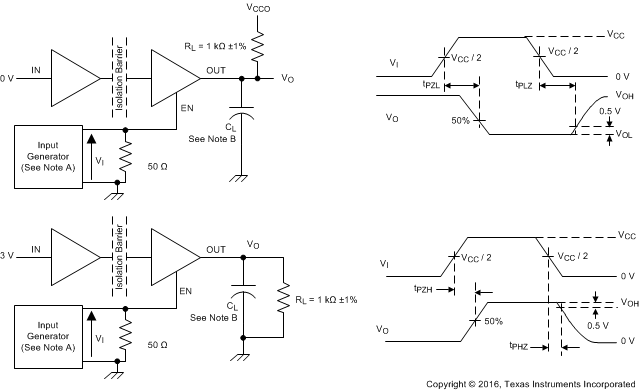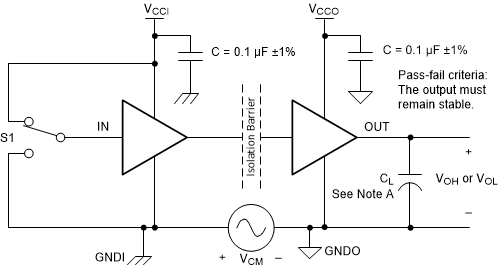SLLSFG4F December 2019 – June 2024
PRODUCTION DATA
- 1
- 1 Features
- 2 Applications
- 3 Description
- 4 Pin Configuration and Functions
-
5 Specifications
- 5.1 Absolute Maximum Ratings
- 5.2 ESD Ratings
- 5.3 Recommended Operating Conditions
- 5.4 Thermal Information
- 5.5 Power Ratings
- 5.6 Insulation Specifications
- 5.7 Safety-Related Certifications
- 5.8 Safety Limiting Values
- 5.9 Electrical Characteristics—5-V Supply
- 5.10 Supply Current Characteristics—5-V Supply
- 5.11 Electrical Characteristics—3.3-V Supply
- 5.12 Supply Current Characteristics—3.3-V Supply
- 5.13 Electrical Characteristics—2.5-V Supply
- 5.14 Supply Current Characteristics—2.5-V Supply
- 5.15 Electrical Characteristics—1.8-V Supply
- 5.16 Supply Current Characteristics—1.8-V Supply
- 5.17 Switching Characteristics—5-V Supply
- 5.18 Switching Characteristics—3.3-V Supply
- 5.19 Switching Characteristics—2.5-V Supply
- 5.20 Switching Characteristics—1.8-V Supply
- 5.21 Insulation Characteristics Curves
- 5.22 Typical Characteristics
- 6 Parameter Measurement Information
- 7 Detailed Description
- 8 Application and Implementation
- 9 Device and Documentation Support
- 10Revision History
- 11Mechanical, Packaging, and Orderable Information
6 Parameter Measurement Information

A. The input pulse is supplied by a generator having
the following characteristics: PRR ≤ 50 kHz, 50% duty cycle,
tr ≤ 3 ns, tf ≤ 3 ns,
ZO = 50 Ω. At the input, 50 Ω resistor is
required to terminate Input Generator signal. The 50 Ω is
not needed in the actual application.
B. CL = 15 pF and
includes instrumentation and fixture capacitance within ±20%.
Figure 6-1 Switching
Characteristics Test Circuit and Voltage Waveforms
A. The input pulse is supplied by a
generator having the following characteristics: PRR ≤ 10 kHz, 50% duty cycle,
tr ≤ 3 ns, tf ≤ 3 ns, ZO = 50 Ω.
tr ≤ 3 ns, tf ≤ 3 ns, ZO = 50 Ω.
B. CL = 15 pF and
includes instrumentation and fixture capacitance within ±20%.
Figure 6-2 Enable/Disable Propagation Delay Time Test Circuit and Waveform
A. CL = 15 pF and
includes instrumentation and fixture capacitance within ±20%.
B. Power Supply Ramp Rate = 10
mV/ns
Figure 6-3 Default
Output Delay Time Test Circuit and Voltage Waveforms
A. CL = 15 pF and
includes instrumentation and fixture capacitance within ±20%.
Figure 6-4 Common-Mode Transient Immunity Test Circuit